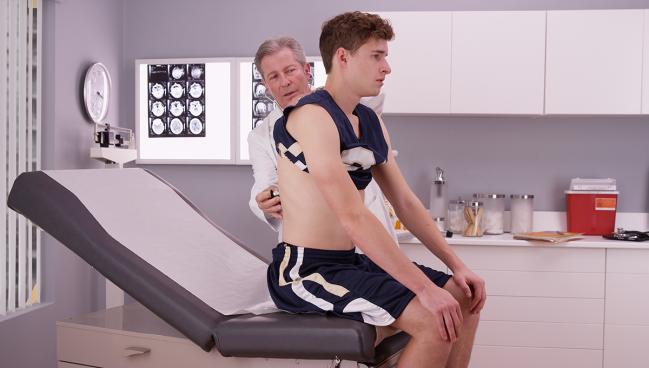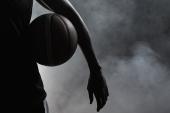Studies Support (Careful) Return to Sport for Athletes With Genetic Conditions
For athletes and weekend warriors with HCM and LQTS, two new studies may offer a ray of hope.

NEW ORLEANS, LA—Two new studies, including one in elite athletes playing at the professional or collegiate level, are providing support for those with genetic heart conditions to return to their respective sports or participate in vigorous physical activity.
The studies, which were presented Monday at the American College of Cardiology/World Congress of Cardiology (ACC/WCC) 2023 meeting, suggest that a diagnosis shouldn’t automatically disqualify individuals with genetic heart conditions from physical activity.
Instead, said Rachel Lampert, MD (Yale University School of Medicine, New Haven, CT), the lead investigator of a large, prospective study of individuals with hypertrophic cardiomyopathy (HCM), the data “should inform discussions between patients and physicians regarding vigorous exercise participation in the context of expert assessment and management of HCM using an individualized shared decision-making framework.”
James Sawalla Guseh, MD (Massachusetts General Hospital, Boston, MA), one of the panelists during the during the late-breaking clinical trials session, said that physicians have historically been paternalistic with patients with genetic heart conditions wanting to participate, or continue to participate, in high-level physical activity. In doing so, they have de-emphasized patient preference and risk tolerance, he said.
“We know that athletes come from all walks of life,” said Guseh. “They are intelligent, and when there’s scientific uncertainty, their values should be incorporated in medical decision-making.”
Katherine Martinez (Loyola University, Chicago, IL), who retrospectively studied collegiate and professional athletes who returned to play after a diagnosis of HCM, long QT syndrome (LQTS), and other abnormalities, added that their data don’t suggest there is an unacceptably high event rate for those who jump back into their respective sports.
“The evidence that we’re presenting counters the idea that this is unacceptable risk-taking behavior,” said Martinez. “We’re not suggesting this is the only way to protect athletes. We’re still advocating for continued use of hands-only CPR and AEDs to add another layer of protection,” she said.
Speaking with the media during an afternoon press conference, Eugene Chung, MD (University of Michigan, Ann Arbor), a member of the ACC Sports and Cardiology Council, said the two presentations will “move the needle” when it comes to managing elite athletes and weekend warriors with cardiac abnormalities, as well as those who simply want to stay physically active. “Not as far back as 20 years ago, we had very restrictive guidelines for many inherited conditions on the return to play,” he said.
Now, these data, along with other ICD studies published in the last decade, suggest that HCM, as well as other inherited conditions, might not pose the extent of risk of sudden cardiac death in athletes as previously believed.
Since the 2005 Bethesda Conference, which helped form the early recommendations around sports and physical activity in patients with cardiovascular abnormalities, subsequent eligibility and disqualification recommendations for competitive athletes with HCM and LQTS have tried to strike a balance between safety and restrictions, with an emphasis on shared decision-making. The 2015 guidelines, for example, state that it’s reasonable for asymptomatic patients with genotype-positive HCM but without evidence of LV hypertrophy to participate in competitive athletics (class IIa, level of evidence C). However, they go on to say, athletes with probable or unequivocal HCM and clinical expression of LV hypertrophy should probably not participate in most competitive sports, the exception being low-intensity sports, such as bowling, cricket, curling, golf, riflery, and yoga.
Speaking with the media during the ACC press conference, Lampert said that while the physical and psychological benefits of exercise are well documented, the heightened concern for ventricular arrhythmia and sudden cardiac death led to the prior restrictions on vigorous exercise for those with HCM. That recommendation, however, didn’t have much data to back it up, she said, noting that prospective, comparative outcomes were lacking on the safety of vigorous exercise.
LIVE-HCM
In the LIVE-HCM study, which was conducted at 42 sites in the United States, United Kingdom, Australia, and New Zealand, researchers prospectively studied 1,660 patients with a clinical diagnosis of HCM or those who were genotype-positive without evidence of LV hypertrophy. In total, 699 individuals participated in vigorous exercise, which was defined as physical activity with METS ≥ 6 for 60 or more hours per year.
Overall, researchers observed no difference in the rate of the primary composite endpoint of death, resuscitated cardiac arrest, syncope, or appropriate shock from an ICD between those who participated in vigorous activity and those who did not (15.9 vs 15.3 events per 1,000 person-years). In a Cox proportional hazards model, there was no significant difference in risk seen between the vigorous-exercise group and those who were less active (HR 1.01; 95% CI 0.68-1.48). This met the statistical definition for noninferiority (upper boundary for HR 1.5). Individual event rates were similar in the vigorous and non-vigorous groups, but the numbers were small and too infrequent for meaningful comparisons.
The evidence that we’re presenting counters the idea that this is unacceptable risk-taking behavior. Katherine Martinez
In a post hoc analysis restricted to those with overt HCM only, there was no statistical difference in the risk of the primary endpoint between the vigorous and non-vigorous groups. However, this comparison missed the noninferiority margin (HR 1.06; 95% CI 0.72-1.55).
Jonathan Kim, MD (Emory University School of Medicine, Atlanta, GA), one of the panelists during the late-breaking session, said the sports cardiology world has been awaiting data such as these for several years. He pointed out, however, that vigorous exercise as defined in this study is roughly equivalent to the 75 minutes per week of vigorous activity as recommended by the American Heart Association (AHA). That type of activity differs a great deal from that done by elite-level collegiate and professional athletes.
In response, Lambert noted the study included 259 individuals who performed vigorous physical activity at a competitive level. Even in this analysis, there was no heightened risk of death, resuscitated cardiac arrest, syncope, or appropriate shock from an ICD when compared with those who performed non-vigorous activities. Also, they included 56 athletes competing at the high school or college level, and while the event rate is low, they have not yet had a chance to study these patients in depth, said Lampert.
Chung said that while LIVE-HCM shows that vigorous exercise carries a low risk for patients with HCM, he stressed that all patients were managed by hospitals with experts in inherited genetic abnormalities.
“We need to take care of the disease as well as we have been,” he said. “Risk assessment, shared decision-making, close follow-up, emergency action plans are all important parts of care in the athlete.”
NCAA and Professional Athletes
In the second study, Martinez and colleagues focused exclusively on high-performing athletes participating in college or at the professional level.
They identified 76 patients with a genetic heart condition, including 40 with HCM and 20 with LQTS, who returned to play after the diagnosis. In addition to HCM and LQTS, other diagnoses included dilated cardiomyopathy (DCM), arrhythmogenic right ventricular cardiomyopathy (ARVC), and idiopathic ventricular fibrillation.
Of the athletes (72% male), 49 played division I sports in the National Collegiate Athletic Association (NCAA) and 27 played professionally. The mean age at the time of diagnosis was 19 years and 63% of the athletes were asymptomatic at the time of diagnosis. The majority of athletes (72%) were initially disqualified from playing their sport after the diagnosis.
Overall, three athletes chose not to play again after their evaluation and discussion with experts. Another four athletes were cleared to participate in their sport again, but the team’s medical professionals refused to allow them to play. Of the remaining athletes, three (4%) had one “breakthrough cardiac event” during 200 follow-up years.
One 21-year-old male collegiate basketball player with HCM had an ICD shock while moving furniture and a 21-year-old male collegiate hockey player with LQTS had two episodes of syncope with seizure (one coming off the hockey bench and the other while making dinner). The third athlete, a 23-year-old male professional hockey player, had an episode of syncope while working out.
Matthew Martinez, MD (Atlantic Health System/Morristown Medical Center, NJ), the study’s senior author, said the return-to-play protocol is based on the patient’s initial evaluation and customized treatment plan. If there is unanimous support following that—a buy-in that includes the patient, family, coaches, school administrators, and more—then the patient can return to their respective sport. They will then be evaluated every year to assess risk and possible treatments.
“It’s about an exercise plan,” said Martinez, adding that this includes ongoing surveillance.
Michael Ackerman, MD, PhD (Mayo Clinic, Rochester, MN), another of the senior authors, said that nearly all clinical events occur in undiagnosed and untreated patients. “After it’s found and treated, they can do almost anything they want,” he told TCTMD. “Of course, there are boundaries. The conversation with the athlete is very much stage dependent. It very much evolves.” Ackerman added that if there is buy-in from all involved, most division II or III schools will allow the student to play again.
“It’s totally different at the division I or professional level,” he said. “At these levels, it starts to shift from shared decision-making to what some of us call BDM, a business decision-making model.”
Michael O’Riordan is the Managing Editor for TCTMD. He completed his undergraduate degrees at Queen’s University in Kingston, ON, and…
Read Full BioSources
Martinez KA, Bos JM, Newman DB, et al. Return-to-play for elite level athletes with sudden cardiac death predisposing heart conditions. Presented at: ACC/WCC 2023. March 6, 2023. New Orleans, LA.
Lambert M, Ackerman MJ, Marino BS, et al. Vigorous exercise in individuals with hypertrophic cardiomyopathy: primary results from the prospective, multinational lifestyle and exercise in HCM (LIVE-HCM) study. Presented at: ACC/WCC 2023. March 6, 2023. New Orleans, LA.
Disclosures
- Katherine Martinez reports no relevant conflicts of interest.
- Matthew Martinez is a consultant for the National Football League, National Hockey League, National Basketball Association Players Association, Major League Soccer, and New York Jets.
- Ackerman reports consulting for Abbott, Boston Scientific, Bristol Myers Squibb, Daiichi Sankyo, Invitae, LQT Therapeutics, and Medtronic. He reports intellectual property/royalties with AliveCor, Anumana, ARMGO Pharma, Pfizer, and UpToDate.





Comments